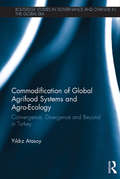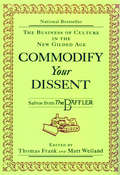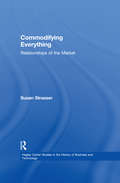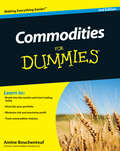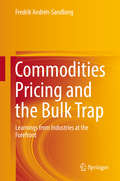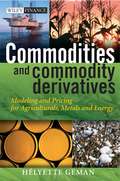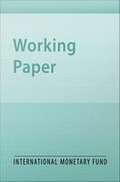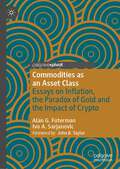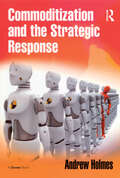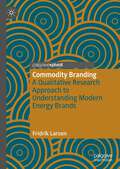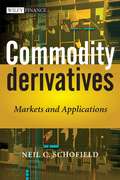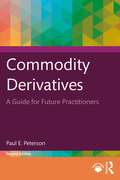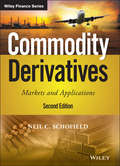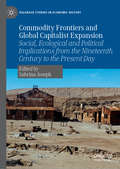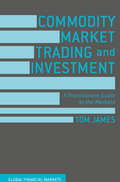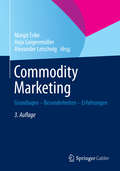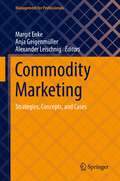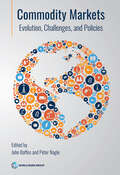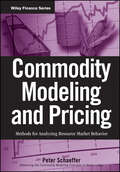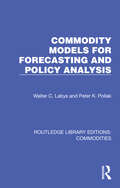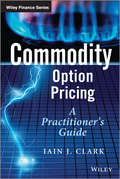- Table View
- List View
Commodification of Global Agrifood Systems and Agro-Ecology: Convergence, Divergence and Beyond in Turkey (Routledge Studies in Governance and Change in the Global Era)
by Yıldız AtasoyThis book explores the shifting relations of food provisioning in Turkey from a comparative global political economy perspective. It offers in-depth ethnographic analysis, interviews and historical insights into the ambiguities and diversities that simultaneously affect the changing conditions of food and agriculture in Turkey. Specific issues examined include the commodification of land, food and labour; the expansion and deepening of industrial standardization; the expansion of a supermarket model; and concomitant changes in, as well as the simultaneous co-existence of, traditional methods of production and marketing. Contrasting observations are drawn from diverse locales to provide examples of convergence, divergence and cohabitation in relation to transnationally advocated industrial models. Commodification of Global Agrifood Systems and Agro-Ecology employs a form of comparative perspective that allows the particular processes of restructuring of agrifood relations in Turkey to be simultaneously distinguished from, yet related to, changes taking place in global power dynamics. Yıldız Atasoy explores agrifood transformation in Turkey with a unique approach that considers a plurality of intertwined normative influences, ontological beliefs, cultural–religious narratives, political struggles and critical–interpretive positions. Based on original research, the book treats changes in food provisioning as an analytical thread capable of uncovering how the normative acceptability of capitalized agriculture and techno-scientific innovation is entangled with processes of class formation, growing inter-capitalist competition and Islamic politics. Such processes, in turn, frame income/wealth generation, landscape management, agro-ecological dynamics and labour practices, as well as the taste and smell of place.
Commodify Your Dissent: Salvos from The Baffler
by Thomas Frank Matt WeilandFrom the pages of The Baffler, the most vital and perceptive new magazine of the nineties, sharp, satirical broadsides against the Culture Trust. In the "old" Gilded Age, the barons of business accumulated vast wealth and influence from their railroads, steel mills, and banks. But today it is culture that stands at the heart of the American enterprise, mass entertainment the economic dynamo that brings the public into the consuming fold and consolidates the power of business over the American mind. For a decade The Baffler has been the invigorating voice of dissent against these developments, in the grand tradition of the muckrakers and The American Mercury. This collection gathers the best of its writing to explore such peculiar developments as the birth of the rebel hero as consumer in the pages of Wired and Details; the ever-accelerating race to market youth culture; the rise of new business gurus like Tom Peters and the fad for Hobbesian corporate "reengineering"; and the encroachment of advertising and commercial enterprise into every last nook and cranny of American life. With its liberating attitude and cant-free intelligence, this book is a powerful polemic against the designs of the culture business on us all.
Commodifying Everything: Relationships of the Market (Hagley Center Studies in the History of Business and Technology #Vol. 4)
by Susan StrasserCommodification refers most explicitly to the activities of turning things into commodities and of commercializing that which is not commercial in essence. The mass marketing of pets, the rise of the coffin industry, the conversion of preacher into salesmen, and the globalization of Taleggio cheese are some of the exciting but surprising topics in this volume that show how friendship, death, spirituality, and artisanship all have a price after being commodified. This unique collection of essays is a fascinating take on creating consumer products and consumer identities when what's for sale goes well beyond the thing itself. It will be a course-in-a-box for instructors who want to teach their students about commodification.
Commodities For Dummies
by Amine BouchentoufAdd another dimension to your portfolio with commodities Commodities For Dummies gives you a complete overview of the basics of investing in commodities. Step-by-step explanations, plus the most up-to-date market information and global events, make it easy to invest in the stuff the world is made of. This book helps you identify the most valuable commodities to add to your portfolio, use commodities as a safe haven in shifting economic times, and come out on top. Learn quick, with real-life examples, expert advice, and basic explanations to get you involved in energy, agriculture, and metals. Pick up this book, and you’ll be ready to select the right investment vehicles for you, manage risk, and reap the benefits of investing in commodities—the Dummies way. Get a crash course in the basics of global commodity trading and investing Discover how recent global events have impacted commodity prices and supply chains Find the right balance of commodities for your portfolio—in any market weather Understand the importance of ESG and renewables in the commodity investing landscapeThis is the perfect Dummies guide for investors who have a good grasp of the basics and want to continue to diversify their portfolio with—you guessed it—commodities.
Commodities For Dummies, 2nd Edition
by Amine BouchentoufGet more bang for your buck in the commodities market and start trading today While Wall Street has been troubled, commodity markets have been soaring. Since 2002, commodities have outperformed every other asset class including stocks, mutual funds, and real estate. This hands-on, friendly guide gives you the basics on breaking into the market, dispels common myths, and shows you how to implement a wide range of trading and investing strategies. It also helps you diversify your portfolio, measure risk, and apply market analysis techniques. Expanded coverage of the types of commodities available to investors Advice on how to manage the risks and rewards of commodities Updated examples and information on SEC rules and regulations (and tax laws) Featuring time-tested rules for investment success Commodities For Dummies helps you minimize risk, maximize profit, and find the shortest route to Easy Street.
Commodities Pricing and the Bulk Trap: Learnings from Industries at the Forefront
by Fredrik Andrén-SandbergThis book takes a fresh look at pricing, product differentiation and the need for decommoditisation in market sectors where products and services are standardised and interchangeable. In the first chapters the book explains what commodities are, and puts them into a historical perspective to promote an understanding of their production and its effects. From this baseline the book then presents a case study on how decommoditisation has progressed within the energy industry. Building on this case study and learnings from other sectors, it develops a theoretical framework, characterising the processes and mechanisms observed to be extended towards different industries. This framework is then utilised in the following chapters as a model to explain the progression of decommoditisation, and to examine other sectors through this lens. To conclude, the book presents the implications for stakeholders and suggestions on how to respond to them from a policy and business standpoint. In a final chapter the book develops an outlook on current trends and possible alternative pathways, and summarizes the main takeaways for management professionals and policymakers alike.
Commodities and Commodity Derivatives: Modeling and Pricing for Agriculturals, Metals and Energy
by Helyette GemanThe last few years have been a watershed for the commodities, cash and derivatives industry. New regulations and products have led to an explosion in the commodities markets, creating a new asset for investors that includes hedge funds as well as University endowments, and has resulted in a spectacular growth in spot and derivative trading. This book covers hard and soft commodities (energy, agriculture and metals) and analyses: Economic and geopolitical issues in commodities markets Commodity price and volume risk Stochastic modelling of commodity spot prices and forward curves Real options valuation and hedging of physical assets in the energy industry It is required reading for energy companies and utilities practitioners, commodity cash and derivatives traders in investment banks, the Agrifood business, Commodity Trading Advisors (CTAs) and Hedge Funds. In Commodities and Commodity Derivatives, Hélyette Geman shows her powerful command of the subject by combining a rigorous development of its mathematical modelling with a compact institutional presentation of the arcane characteristics of commodities that makes the complex analysis of commodities derivative securities accessible to both the academic and practitioner who wants a deep foundation and a breadth of different market applications. It is destined to be a "must have" on the subject. " -Robert Merton, Professor, Harvard Business School "A marvelously comprehensive book of interest to academics and practitioners alike, by one of the world's foremost experts in the field. " -Oldrich Vasicek, founder, KMV
Commodities and the Market Price of Risk
by Shaun K. RoacheA report from the International Monetary Fund.
Commodities as an Asset Class: Essays on Inflation, the Paradox of Gold and the Impact of Crypto (Palgrave Studies in Classical Liberalism)
by Alan G. Futerman Ivo A. SarjanovicThis book challenges the notion that commodities are always good hedges against inflation, which is the conventional belief today in financial markets. Specifically, it focuses on gold as a traditional hedge and the ways in which crypto assets are argued to be positioned as an alternative hedge against inflationary risk.The book engages with emerging debates around the performance of gold since the 2008 financial crisis, analyzing its characteristics, relationship with inflation, and the role of mining companies, and discusses ways that cryptocurrencies have replaced precious metals as an attractive asset class during an inflationary scenario. In considering the case of crypto as being or not a good inflation hedge, the book devotes particular attention to the theoretical financial and macroeconomic implications of a monetary system based on Bitcoin, dealing with the concept of money and the determination of Bitcoin’s supply and purchasing power. Additionally, it outlines the consequences that such a system would entail for the banking industry, and financial conditions involving interest rates, exchange rates, and the inflation-deflation dynamic. The book also analyses the relative impact of past and future events on the different commodity families.This work will be of interest to students and researchers in financial economics, macroeconomics, and monetary economics, as well as analysts and traders in financial and commodity markets.
Commodities, Ports and Asian Maritime Trade Since 1750 (Cambridge Imperial and Post-Colonial Studies Series)
by Ulbe Bosma Anthony WebsterThis book examines the role of mercantile networks in linking Asian economies to the global economy. It contains fourteen contributions on East, Southeast and South Asia covering the period from 1750 to the present.
Commoditization and the Strategic Response
by Andrew HolmesOrganizations and those who work within them are under attack from the increasingly pervasive impacts of commoditization. With little to distinguish one company's products and services from another or one person's skills and capabilities from the next, organizations and workers alike are finding themselves trapped in the me-too hell of commoditization. For many this means the survival of the cheapest, as price becomes the principal basis for decision making. For others it requires them to think creatively to avoid the trap of commoditization, even though this may only provide a temporary respite. In this groundbreaking book, Andrew Holmes sets out why commoditization represents such a clear and present danger to every corporation and all white-collar workers. Starting with the nature of the commodities we are familiar with such as coal and cotton, Holmes moves on to describe how commoditization is affecting entire industries and is increasingly touching the work of the professional classes. The evidence is both fascinating and compelling and it is clear that the impacts of commoditization are far reaching. The author also outlines the impact of commoditization on an organization's strategy towards brand, supply chain, value chain, innovation, pricing and competition. He explores the implications for skills, attitudes and behaviours in the workplace before describing a series of strategies for avoiding the risk and exploiting the opportunities offered by a new commoditized world, such as outsourcing, innovation, offshoring, mergers and acquisitions, divestments and first mover advantage. Holmes offers organizations and white-collar workers a range of strategic responses which can be used to combat its worst impacts. And as commoditization continues to make inroads into the corporate and working worlds, this book will be an invaluable companion to addressing the challenges which it presents.
Commodity Branding: A Qualitative Research Approach to Understanding Modern Energy Brands
by Fridrik LarsenWhen it comes to branding the energy space, an exciting and largely unexplored field of research emerges. Energy companies are under the spotlight as consumers press for positive action on sustainability, CSR, and environmental issues. In light of this, this book has two objectives. First, the author explores the challenges and opportunities that experts within the field face when deciding on strategic brand direction. The results indicate that practitioners in recently liberalised markets have met the emerging branding challenges, such as differentiating commodities, meeting new consumer demands, and building strong brands. Second, the book examines, from an expert-practitioner point of view, whether branding and building brands are activities relevant to this type of market. This book, therefore, attempts to fill a literature gap, as it examines the applicability of theoretical and practical methods of branding and brand strategies in a commodity market, in this case the energy market.
Commodity Derivatives
by Neil C. SchofieldIn Commodity Derivatives: Markets and Applications, Neil Schofield provides a complete and accessible reference for anyone working in, or studying commodity markets and their associated derivatives. Dealing primarily with over the counter structures, the book provides extensive coverage of both hard and soft commodities, including gold, crude oil, electricity, plastics, emissions and agriculturals.Using structures unique to the individual market, each chapter includes an explanation of the commodity and an analysis of its physical market, discussion on the typical patterns of demand and supply and the main factors that will influence the price of the commodity, and the main products.Each chapter focuses on how the products could be used along the physical supply chain and seeks to identify the main market risks and how they can be hedged. The book then brings into perspective how the structuring banks hedge their own resultant exposure and examines the attraction of OTC investment structures for the wholesale market.Commodity Derivatives: Markets and Applications is essential reading for those wishing to learn about the main features of the commodity markets, the mechanics of derivatives, and how they are applied.
Commodity Derivatives: A Guide for Future Practitioners
by Paul E. Peterson<p>Commodity Derivatives: A Guide for Future Practitioners describes the origins and uses of these important markets. Commodities are often used as inputs in the production of other products, and commodity prices are notoriously volatile. Derivatives include forwards, futures, options, and swaps; all are types of contracts that allow buyers and sellers to establish the price at one time and exchange the commodity at another. <p>These contracts can be used to establish a price now for a purchase or sale that will occur later, or establish a price later for a purchase or sale now. This book provides detailed examples for using derivatives to manage prices by hedging, using futures, options, and swaps. It also presents strategies for using derivatives to speculate on price levels, relationships, volatility, and the passage of time. Finally, because the relationship between a commodity price and a derivative price is not constant, this book examines the impact of basis behaviour on hedging results, and shows how the basis can be bought and sold like a commodity. <p>The material in this book is based on the author’s 30-year career in commodity derivatives, and is essential reading for students planning careers as commodity merchandisers, traders, and related industry positions. Not only does it provide them with the necessary theoretical background, it also covers the practical applications that employers expect new hires to understand. Examples are coordinated across chapters using consistent prices and formats, and industry terminology is used so students can become familiar with standard terms and concepts. This book is organized into 18 chapters, corresponding to approximately one chapter per week for courses on the semester system.</p>
Commodity Derivatives: A Guide for Future Practitioners
by Paul E. PetersonCommodity Derivatives: A Guide for Future Practitioners describes the origins and uses of these important markets. Commodities are often used as inputs in the production of other products, and commodity prices are notoriously volatile. Derivatives include forwards, futures, options, and swaps; all are types of contracts that allow buyers and sellers to establish the price at one time and exchange the commodity at another.This straightforward book provides the necessary theoretical background and covers the practical applications that employers expect new hires to understand. Detailed examples are provided for using derivatives to manage prices by hedging, while strategies are presented for speculating on derivatives. This book also examines the impact of basis behavior on hedging results and shows how the basis can be bought and sold like a commodity. Examples are coordinated across chapters using consistent prices and formats, and industry terminology is used so students can become familiar with standard terms and concepts. This second edition has been fully revised and includes new chapters on futures pricing and risk measures for commodity markets, as well as expanded material on commodity swaps.A test bank of questions and problems also accompanies this edition, which instructors can use for homework assignments, review purposes, or exams. This book is essential reading for students planning careers as commodity merchandizers, traders, and related industry positions.
Commodity Derivatives: Markets and Applications (The Wiley Finance Series)
by Neil C. SchofieldCommodity Derivatives In the newly revised Second Edition of Commodity Derivatives: Markets and Applications, expert trading educator and author Neil Schofield delivers a comprehensive overview of a wide variety of commodities and derivatives. Beginning with discussions of commodity markets generally before moving on to derivative valuation and risk management, the author then dives into individual commodity markets, like gold, base metals, crude oil, natural gas, electricity, and more.Schofield relies on his extensive experience at Barclays Investment Bank to offer readers detailed examinations of commodity finance and the use of commodities within a wider investment portfolio.The second edition includes discussions of critical new topics like dual curve swap valuation, option valuation within a negative price environment using the Bachelier model, volatility skews, smiles, smirks, term structures for major commodities, and more. You’ll find case studies on corporate failures linked to improper commodity risk management, as well as explorations of issues like the impact of growing interest in electric vehicles on commodity markets.The text of the original edition has been updated and expanded and new example transactions are included to help the reader understand the concepts discussed within. Each chapter follows a uniform structure, with typical demand and supply patterns following a non-technical description of the commodity at issue. Discussions of the physical markets in each commodity and the main exchange-traded and over-the-counter products conclude each chapter.Perfect for commodity and derivatives traders, analysts, and risk managers, the Second Edition of Commodity Derivatives: Markets and Applications will also earn a place in the libraries of students and academics studying finance and the graduate intake in financial institutions.A one-stop resource for the main commodity markets and their associated derivativesFinance professionals seeking a single volume that fully describes the major commodity markets and their derivatives will find everything they need in the latest edition of Commodity Derivatives: Markets and Applications. Former Global Head of Financial Markets Training at Barclays Investment Bank Neil Schofield delivers a rigorous and authoritative reference on a crucial, but often overlooked, subject.Completely revised and greatly expanded, the Second Edition of this essential text offers finance professionals and students coverage on every major class of commodities, including gold, steel, ethanol, crude oil, and more. You’ll also find discussions of derivative valuation, risk management, commodity finance, and the use of commodities within an investment portfolio.Non-technical descriptions of major commodity classes ensure the material is accessible to everyone while still in-depth and rigorous enough to deliver key information on an area central to global finance.Ideal for students and academics in finance, Commodity Derivatives is an indispensable guide for commodity and derivatives traders, analysts, and risk managers who seek a one-volume resource on foundational and advanced topics in commodity markets and their associated derivatives.
Commodity Frontiers and Global Capitalist Expansion: Social, Ecological and Political Implications from the Nineteenth Century to the Present Day (Palgrave Studies in Economic History)
by Sabrina JosephThis interdisciplinary edited collection explores the dynamics of global capitalist expansion through the concept of the ‘commodity frontier’. Applying an inductive approach rather than starting at the global level, as most meta-narratives have done, this book sheds light on how local dynamics have shaped the process of capitalist expansion into ‘uncommodified’ spaces. Contributors demonstrate that ultimately the evolution of frontier zones and their reconfiguration over time have transformed human ecology, labour relations and social, economic and political structures across the globe. Chapters examine agricultural and pastoral frontiers, natural habitats, and commodity frontiers with fossil fuels and mineral resources located in various regions of the world, including South America, Asia, Africa and the Arabian Gulf.
Commodity Market Trading and Investment: A Practitioners Guide to the Markets (Global Financial Markets)
by Tom JamesThis book offers practical knowledge, analysis, trading techniques and methodologies required for the management of key international commodities. The author explores each aspect of commodity trading in detail and helps the reader to implement effective techniques to build a strong portfolio. Early chapters set the current scene of commodity trading markets before going on to discuss the fundamental instruments and tools used in navigating commodity markets. The author provides detailed, empirical case studies of traded natural resources in order to explicate the financial instruments that enable professionals both to invest and to trade them successfully. Later chapters investigate the psychology and behavioural influences behind optimal market trading, in which the author encourages the reader to understand and combat the obstacles that prevent them from reaching their full trading potential.
Commodity Marketing: Grundlagen - Besonderheiten - Erfahrungen
by Margit Enke Anja Geigenmüller Alexander LeischnigDie Abgrenzung von Angeboten der Wettbewerber sowie die Profilierung der eigenen Leistungen gegenüber den Kunden ist insbesondere bei Commodities, d. h. undifferenzierten, homogenen und maßgeblich über den Preis unterscheidbaren Leistungen, eine große Herausforderung. Die Besonderheiten von Commodities haben dabei einen wesentlichen Einfluss auf die Ausgestaltung der Management- und Marketingaktivitäten. Renommierte Autoren aus Wissenschaft und Praxis liefern in ,,Commodity Marketing" den State of the Art zu diesem Themengebiet. In der 3. Auflage wurden bisherige Erkenntnisse zum Commodity Marketing um aktuelle Ergebnisse ergänzt. Darüber hinaus wurde das Buch um eine internationale Perspektive erweitert und geht somit Fragestellungen des Commodity Marketing im internationalen Kontext nach.
Commodity Marketing: Strategies, Concepts, and Cases (Management for Professionals)
by Margit Enke Anja Geigenmüller Alexander LeischnigCommoditization is a major challenge for companies in a wide range of industries, and commodity marketing has become a priority for many top managers. This book tackles the key issues associated with the marketing of commodities and the processes of commoditization and de-commoditization. It summarizes the state of the art on commodity marketing, providing an overview of current debates. It also offers managerial insights, case studies, and guidance to help manage and market commodity goods and services.
Commodity Markets and the Global Economy
by Blake C. ClaytonIn an era defined by financial upheaval, few parts of the economy have witnessed the kind of volatility seen in commodities markets. In this book, Blake Clayton, a Wall Street analyst and adjunct fellow at the Council on Foreign Relations, draws on the latest thinking from academia and the private sector to deliver a clear-eyed analysis of pressing questions at the intersection of commodity markets, natural resource economics, and public policy. The result is a work that challenges the conventional wisdom about how these markets function and provides a fresh perspective on what public policy can do to improve them.
Commodity Markets: Evolution, Challenges, and Policies
by Peter Nagle John BaffesCommodity markets are integral to the global economy. Understanding what drives developments of these markets is critical to the design of policy frameworks that facilitate the economic objectives of sustainable growth, inflation stability, poverty reduction, food security, and the mitigation of climate change. This study is the first comprehensive analysis examining market and policy developments for all commodity groups, including energy, metals, and agriculture, over the past century. It finds that, while the quantity of commodities consumed has risen enormously, driven by population and income growth, the relative importance of commodities has shifted over time, as technological innovation created new uses for some materials and facilitated substitution among commodities. The study also shows that commodity markets are heterogeneous in terms of their drivers, price behavior, and macroeconomic impact on emerging markets and developing economies, and that the relationship between economic growth and commodity demand varies widely across countries, depending on their stage of economic development. Policy frameworks that enable countercyclical macroeconomic responses have become increasingly common—and beneficial. Other policy tools have had mixed outcomes. Discussions about commodity-exporting emerging markets are often based on ideas without empirical or analytical support. This book is a great contribution to improve our understanding of those economies, based on rigorous research. It provides robust empirical evidence including a long-term perspective on commodity prices. It also contains very thoughtful policy analysis, with implications for resilience, macroeconomic policies, and development strategies. It will be a key reference for scholars as well as policy makers. José De Gregorio Dean of the School of Economics and Business Universidad de Chile Former Minister of Economy, Mining and Energy and Former Governor of the Central Bank of Chile A sound understanding of commodity markets is more essential than ever in light of the COVID-19 pandemic, the war in Ukraine, and the transition from fossil fuels to renewable energy commodities. This volume offers an excellent, comprehensive, and very timely analysis of the wide range of factors that affect commodity markets. It carefully surveys historical and future trends in commodity supply, demand, and prices, and offers detailed policy proposals to avoid the havoc that turbulent commodity markets can cause on the economies of commodity exporters and importers. Rick Van der Ploeg Research Director of Oxford Centre for the Analysis of Resource-Rich Economies University of Oxford
Commodity Modeling and Pricing
by Peter V. SchaefferCommodity Modeling and Pricing provides extensions and applications of state-of-the-art methods for analyzing resource commodity behavior. Drawing from the seminal work of Professor Walter Labys on the development of econometric methods for forecasting commodity prices, this collection of essays features expert contributors ranging from practitioners in private industry, public sector, and nongovernmental organizations to scholars in higher education-all of whom were Labys's former students or collaborators. Filled with in-depth insights and expert advice, Commodity Modeling and Pricing contains the information you need to excel in this demanding environment.
Commodity Models for Forecasting and Policy Analysis (Routledge Library Editions: Commodities #4)
by Walter C. Labys Peter K. PollakOriginally published in 1984 this book remains as relevant as when it was first published. At that time the oil crises of the 1970s and the growing international debt burden highlighted the extent to which events in primary commodity markets continue to influence the economies of developing and industrialized economies alike. Commodity modelling has become a valuable tool in efforts to predict and understand the behaviour of commodity markets and thereby reduce their fluctuations. This book provides an overview of the nature of the different types of commodity model as well as their diverse applications. In non-technical language the reader is introduced to the underlying modelling methodologies, including their advantages, limitations and commodity specific implications. The book will be of interest to commodity economists, traders and analysts, economic planners and those involved in agricultural, mineral and energy modelling.
Commodity Option Pricing
by Iain J. ClarkCommodity Option Pricing: A Practitioner's Guide covers commodity option pricing for quantitative analysts, traders or structurers in banks, hedge funds and commodity trading companies.Based on the author's industry experience with commodity derivatives, this book provides a thorough and mathematical introduction to the various market conventions and models used in commodity option pricing. It introduces the various derivative products typically traded for commodities and describes how these models can be calibrated and used for pricing and risk management. The book has been developed with input from traders and examples using real world data, together with relevant up to date academic research.The book includes practical descriptions of market conventions and quote codes used in commodity markets alongside typical products seen in broker quotes and used in calibration. Also discussed are commodity models and their mathematical derivation and volatility surface modelling for traded commodity derivatives. Gold, silver and other precious metals are addressed, including gold forward and gold lease rates, as well as copper, aluminium and other base metals, crude oil and natural gas, refined energy and electricity. There are also sections on the products encountered in commodities such as crack spread and spark spread options and alternative commodities such as carbon emissions, weather derivatives, bandwidth and telecommunications trading, plastics and freight.Commodity Option Pricing is ideal for anyone working in commodities or aiming to make the transition into the area, as well as academics needing to familiarize themselves with the industry conventions of the commodity markets.
